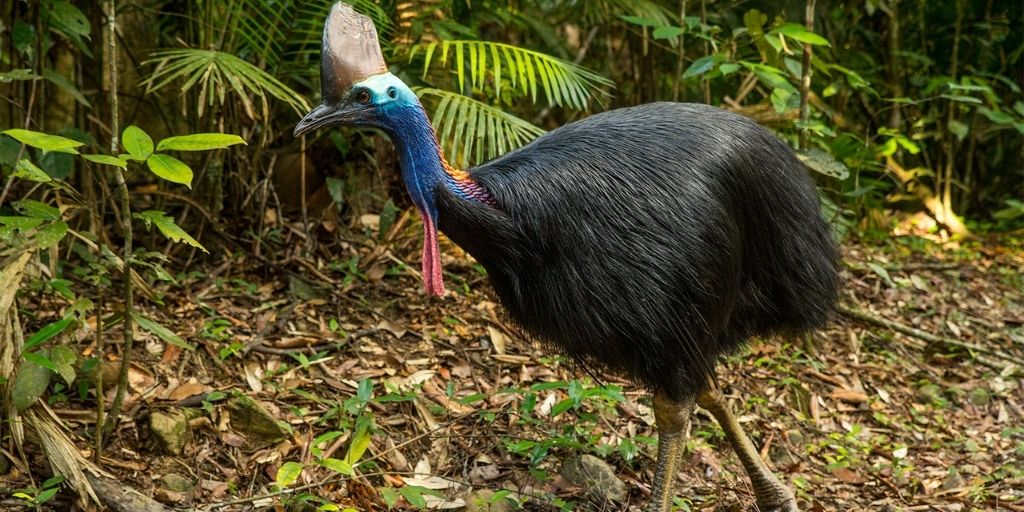What are the biggest birds in the world?
Read our roundup below to discover more about the planets’ largest birds.
However you define them – the tallest birds, the heaviest birds, longest birds, largest living bird, birds with the biggest wingspan, the largest flying birds, or whatever other categories of biggest birds you can think of!
What is a bird?
Fossil indicates that birds are descended from the only surviving group of dinosaurs – avian dinosaurs. Modern-day birds are one of the six basic animal groups (alongside amphibians, fish, invertebrates, mammals, and reptiles), categorised as the biological class Aves.
Birds are defined by their feathers, toothless beaked jaws, and a strong but lightweight skeleton. They reproduce by laying hard-shelled eggs.
Today birds come in many shapes and sizes – from the smallest birds such as the bee hummingbird through to the non-flying giants like ostriches, emus, and cassowaries.
So, with this context in mind, here’s our take on the top 15 largest birds in the world, ranked by height.
Common Ostrich
Up to 2.8 meters tall and 160 kg

A group of common ostriches – the world’s biggest birds
What is the biggest bird in the world? No contest, the common ostrich (Struthio camelus) is the biggest bird in the world.
It’s both the tallest and heaviest, with an average height of over 2 meters (sometimes as tall as 2.8 meters) and a weight of up to 160 kg.
At this size, the ostrich is, of course, a flightless bird, but can outrun plenty of animals with its top speed of 69 km per hour, which makes it the fastest animal on two legs.
Their long, powerful legs double up as defensive weapons which pack a powerful kick to would-be predators.
Fun ostrich fact – they are able to survive without water for days, generating water internally and extracting water from vegetation.
Somali ostrich
Up to 2.7 meters tall and 130 kg

A Somali ostrich strolling
The Somali ostrich (Struthio molybdophanes) was considered a sub-species of common ostrich until 2014, when it was assigned as a distinct species.
Native to Somalia and parts of Ethiopia and Kenya, the Somali ostrich is generally a little lighter than it’s common ostrich cousin, but is just as impressive with its running speed, and is able to cover 5 meters in a single stride!
Emu
Up to 1.9 meters tall and 60 kg

The emu – Australia’s biggest bird
Australia’s emus (Dromaius novaehollandiae) are like a shaggier, slightly smaller ostrich, and like ostriches are not built for flight.
The females of the species are larger than the males and can reach 1.9 meters tall – which makes them the third largest bird in the world.
They are fast birds too, able to reach 48 kilometers per hour, using their three-toed feet and tiny wings to keep them stable when running.
Southern Cassowary
Up to 1.8 meters tall and 85 kg

Watch out – a southern cassowary!
The southern cassowary (Casuarius casuarius) is a huge, flightless, black bird found in north-eastern Australia, Indonesia, and New Guinea.
One of three cassowary species, they also go by the names double-wattled cassowary, Australian cassowary, and two-wattled cassowary.
As well as being the fourth-largest bird in the world, the southern cassowary has a claim to be the most dangerous bird on Earth.
Each of their large feet has sharp 13-centimeters claws they use to kick out in defense, and have been known to kill humans.
Dalmatian Pelican
Up to 1.75 meters tall and 15 kg

A dalmatian pelican relaxing on the water
The heaviest and one of the largest flying birds in the world, this pelican can weigh 15 kilograms and stand at 1.75 meters high.
The Dalmatian pelican (Pelecanus crispus) is native to Eurasia, usually found in rivers, lakes, and estuaries in southeastern Europe, Russia, India, and China.
They are social birds, living and traveling mainly in flocks, and mating with one partner for life. They don’t look particularly graceful when on land, but they swim and fly strongly.
Northern Cassowary
Up to 1.7 meters tall and 70 kg

The speedy northern cassowary
A smaller cousin of the southern cassowary, the northern cassowary (Casuarius unappendiculatus) is endemic to northern New Guinea.
The females of the species are larger than the males, weighing up to 70 kilograms and standing 1.7 meters tall.
Despite their stocky build, the northern cassowary – also known as the single or one-wattled cassowary or gold-necked cassowary – can run in bursts at 50 kilometers an hour.
Mute Swan & Trumpeter Swan
Up to 1.7 meters tall and 14 kg

A mute swan – one of the heaviest flying birds
Both mute swans (Cygnus olor) and trumpeter swans (Cygnus buccinator) are similar build, height, and weight, and are two of the heaviest flying birds on Earth.
These swans look graceful and elegant but have a dangerous side when defending their families or territories – standing up tall and hissing or assaulting intruders with their beaks and wings.
Attacks on humans on water and land are relatively common.
Greater Rhea
Up to 1.5 meters tall and 35 kg

A greater rhea at sunset
Greater rheas (Rhea americana) are the largest birds in the Americas, native to Argentina, Bolivia, Brazil, Paraguay, and Uruguay.
As with so many birds on this list, the greater rhea is flightless and fast, able to reach 35 kilometers per hour using their long, powerful legs.
Along with their high speeds, they protect themselves from predators by gathering in flocks of up to 100 birds during the non-breeding season.
Marabou Stork
Up to 1.5 meters tall and 8 kg

Marabou stork
Marabou storks (Leptoptilos crumenifer) are large wading birds found in Africa south of the Sahara – in both wet and arid habitats, often near human habitation, particularly landfill sites.
Marabous are scavengers eating anything from termites, flamingos, and small birds and mammals to human refuse and dead elephants.
They also feed on carcasses with other scavengers such as vultures and hyenas.
They’re an unusual looking bird, bald-headed with wisps of hair, perhaps worthy of their addition to the ugly five.
They have a wingspan of up to 3.2 meters and a height of 1.5 meters. Interesting maribou stork fact: they have hollow leg and feet bones, an adaptation to help them fly.
Shoebill
Up to 1.5 meters tall and 6 kg

Dinosaur or shoebill stork?
The solitary shoebill stork (Balaeniceps rex) is a very large bird, growing up to 1.5 meters high. Males are usually taller than females and have much longer bills.
All shoebills have a blue-gray, slaty plumage with black-tipped and green-tinted feathers.
They are predominantly carnivorous birds, and their size – and enormous beak – allows them to hunt anything from water snakes to catfish, and even the occasional monitor lizard.
Domestic Turkey
Up to 1.3 meters tall and 39 kg

Domestic turkey – too fat to fly!
Wild and domestic turkeys are the same species, native to North America.
Unlike wild turkeys, however, domestic turkeys (Meleagris gallopavo f. domestica) are not able to fly as they have been selectively bred to be so heavy.
Because they’re unable to fly they don’t use their breast muscles, meaning their breast meat is white – unlike wild turkeys which have dark, gamey breast meat.
Emperor Penguin
Up to 1.3 meters tall and 24 kg

Emperor penguin enjoying the sunshine
Emperor penguins (Aptenodytes forsteri) are the tallest and heaviest of all penguins, and are found only in Antarctica.
Male and female emperor penguins are flightless and similar in size and colouring to females, but perform very different functions in the breeding season.
Hundreds of male Emperor penguins huddle together to protect their eggs from the extreme cold for two months of the dark Antarctic winter as the females head out to sea to hunt.
During this time males lose close to half of their body weight.
Lesser Rhea
Up to 1 meter tall and 20 kg

A Patagonian lesser rhea
The lesser rhea – or Darwin’s rhea – (Rhea pennata), stands up to 1 meter tall and weighs in at around 20 kilograms.
It’s found in South America, roaming both the Andean altiplano and the open Patagonian steppe. Lesser rheas occur singly or in small groups, and males take care of their young birds.
King Penguin
Up to 1 meter tall and 18 kg

Group of king penguins
King penguins (Aptenodytes patagonicus) live on selected islands in the outer reaches of Antarctica, as well as Tierra del Fuego on the tip of the South American continent.
They are the second species of penguins on this list, reaching heights of 1 meter and weights of 18 kilograms – around the same weight as the largest flying birds.
Dwarf Cassowary
Up to 1 meter tall and 13 kg

The splendid dwarf cassowary
The smallest of the cassowary species, but still big enough to make this list, the dwarf cassowary (Casuarius bennetti) also goes by the names of Bennett’s cassowary, little cassowary, mountain cassowary, and mooruk.
Dwarf cassowaries are only found in mountain forests up to elevations of 3,300 meters in New Guinea, New Britain, and Yapen Island.
Cinereous Vulture
Up to 1 meter tall and 10 kg

Cinereous vultures are the world’s largest birds of prey (raptor)
The cinereous vulture (Aegypius monachus) is the heaviest and largest bird of prey in the world.
This Old World vulture has excellent eyesight, allowing it to spot carrion whilst in flight, and a classic vultures’ featherless head to prevent a build-up of blood when it feeds.
Biggest bird in the world, by wingspan: Wandering Albatross

A wandering albatross with wings at full stretch
With a wingspan of up to 3.7 meters wide, the wandering albatross (Diomedea exulans) has the largest wingspan of any living bird on Earth. This enormous wingspan allows the albatross to glide for long distances without the need to flap their wings, which in turn helps define the wandering albatrosses lifestyle as birds which spend most of their lives in flight, landing only to breed and feed.
Largest Flying Land Birds in the Americas: California and Andean Condors

Andean condor on a rock
California condors (Gymnogyps californianus) and Andean condors (Vultur gryphus) are the largest flying birds in North and South America respectively. Though they live at opposite ends of the Americas, both are long-living animals that scavenge on dead mammals.
In terms of body length, the California condor is around 1.4 meters vs the Andean condor at 1.2 meters. However, when it comes to weight (15 kilograms) and wingspan (3.3 meters) the Andean condor is the larger of the two birds.
And that’s your lot for the world’s biggest birds. What do you think – did any of the giant birds on this list surprise you? Or have you seen any of these birds in the wild? Please do share your experiences in the comments section below!



Discover more of our bird posts…
The World’s Largest Flying Birds
November 19, 2020/by Ed17 Iconic Flightless Birds
November 18, 2020/by EdThe Biggest Birds In The World
October 14, 2020/by EdWhy Do Flamingos Stand On One Leg?
August 25, 2020/by EdThe Largest Eagles In The World
November 16, 2020/by EdBirds of Africa
July 1, 2020/by EdThe Fastest Birds In The World – Air, Land & Sea
January 10, 2021/by EdParrots of Africa
July 3, 2020/by EdThe Smallest Birds In The World
October 4, 2020/by Ed